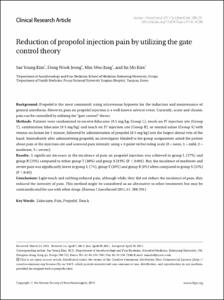KUMEL Repository
1. Journal Papers (연구논문)
1. School of Medicine (의과대학)
Dept. of Anesthesiology & Pain Medicine (마취통증의학)
Reduction of propofol injection pain by utilizing the gate control theory
- Keimyung Author(s)
- Kim, Sae Young; Kim, Jin Mo
- Journal Title
- Anesthesia and Pain Medicine
- Issued Date
- 2011
- Volume
- 61
- Issue
- 4
- Abstract
- Background: Propofol is the most commonly using intravenous hypnotic for the induction and maintenance of
general anesthesia. However, pain on propofol injection is a well known adverse event. Currently, acute and chronic
pain can be controlled by utilizing the “gate control" theory.
Methods: Patients were randomized to receive lidocaine (0.5 mg/kg; Group L), touch on IV injection site (Group
T), combination lidocaine (0.5 mg/kg) and touch on IV injection site (Group B), or normal saline (Group S) with
venous occlusion for 1 minute, followed by administration of propofol (0.5 mg/kg) into the largest dorsal vein of the
hand. Immediately after administering propofol, an investigator blinded to the group assignments asked the patient
about pain at the injection site and assessed pain intensity using a 4-point verbal rating scale (0 = none, 1 = mild, 2 =
moderate, 3 = severe).
Results: A significant decrease in the incidence of pain on propofol injection was achieved in group L (37%) and
group B (23%) compared to either group T (80%) and group S (83%) (P < 0.001). But, the incidence of moderate and
severe pain was significantly lower in group L (7%), group T (20%) and group B (0%) when compared to group S (53%)
(P < 0.05).
Conclusions: Light touch and rubbing reduced pain, although while, they did not reduce the incidence of pain, they
reduced the intensity of pain. This method might be considered as an alternative to other treatments but may be
contraindicated for use with other drugs. (Korean J Anesthesiol 2011; 61: 288-291)
Key Words: Lidocaine, Pain, Propofol, Touch.
- Publisher
- School of Medicine
- Citation
- Sae Young Kim et al. (2011). Reduction of propofol injection pain by utilizing the gate control theory. Anesthesia and Pain Medicine, 61(4), 288–291. doi: 10.4097/kjae.2011.61.4.288
- Type
- Article
- ISSN
- 2005-6419
- Appears in Collections:
- 1. School of Medicine (의과대학) > Dept. of Anesthesiology & Pain Medicine (마취통증의학)
- 파일 목록
-
-
Download
 oak-aaa-00224.pdf
기타 데이터 / 139.49 kB / Adobe PDF
oak-aaa-00224.pdf
기타 데이터 / 139.49 kB / Adobe PDF
-
Items in Repository are protected by copyright, with all rights reserved, unless otherwise indicated.